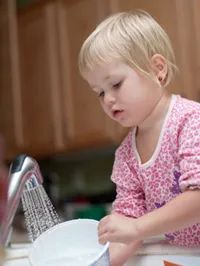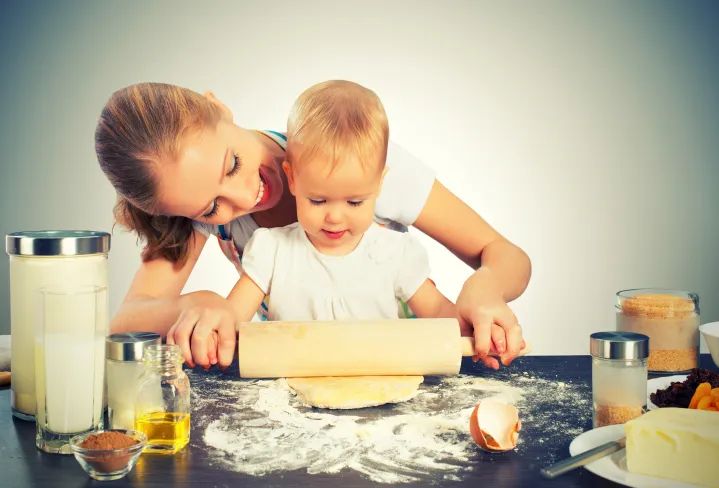6 Great Ways to Create a Learning Environment at Home
Back to School
School is back in session and we parents are either doing a dance of joy, struggling with separation anxiety, or most likely wavering somewhere in-between. Go ahead, take a moment and a deep breath, but don’t go throwing in the towel just yet! Sending your children to even the very best of schools doesn’t let us parents off the educational hook. It is important to continue to foster your child’s educational experience at home and to provide a learning rich environment.
To do this, take a few tips from the profound teachings of Maria Montessori. Montessori’s educational method is based on an in-depth understanding of the child’s stages of development. With that in mind, here are six ways to create a learning environment at home.
1.) Keep On Reading!
 Establish (or maintain) read-aloud routines at home.
Establish (or maintain) read-aloud routines at home.

Studies have consistently shown that children that grow up in “reading families” are more academically successful. Establish read-aloud routines at home. Make it part of your daily activities to enjoy reading aloud to your children, even if it’s only for 5-10 minutes at a time. Reverse the role with older children and let them read aloud to you. Don’t forget to keep yourself reading too. Children that see their parents reading are more likely to think of reading as a fun activity.
2.) Minimize the Clutter
Trying to put too many toys or books out at once can create a feeling of chaos. Instead, rotate a limited selection of items every few weeks. Keep the rest tucked out of sight, ready to be discovered anew at some future date. Children learn best in environments that feel uncluttered and organized. An orderly environment is less distracting, enabling young minds to focus on one task at a time.
3.) Clean Up, Clean Up…
 Don’t underestimate how much children are capable of, even from a very young age.
Don’t underestimate how much children are capable of, even from a very young age.

Show children how to put their things away in baskets, shelves, or cubbies that are within your child’s reach. Make it easy for children to succeed at returning things to their proper places. Demonstrate how to put things away, to get one toy, book, game, etc., out at a time and to put it away before getting another. Explain why this is important (…so things don’t get broken, so that you can find things, so that others don’t step on or trip over things, etc.) and encourage them to do so independently.
4.) Keep it Within Reach
Have a child-friendly area in as many rooms of your home as possible. Provide low shelves and coat/towel hooks within reach. Have child-size tables and chairs in the kitchen and stools to reach sinks, etc. Place a few age-appropriate learning materials such as children’s books, art supplies and instruments in every room (or at least several rooms.) Smaller scale practical-life items such as dishes, utensils, and tools are a must. The more the child can do for herself (because she can reach it, lift it, hold it, etc.) the more you are fostering that vital thing we call independence.
“The child’s first instinct is to carry out his actions by himself, without anyone helping him, and his first conscious bid for independence is made when he defends himself against those who try to do the actions for him.” ~Maria Montessori
 Resist the temptation to do too much for them, and instead, do more with them.
Resist the temptation to do too much for them, and instead, do more with them.

5.) Can I Try?
Don’t underestimate how much children are capable of, even from a very young age. Resist the temptation to do too much for them, and instead, do more with them. Children learn confidence and self-reliance through participating in everyday activities at home. Knowing that they contribute and are productive members of the family, gives children an important sense of self-worth and belonging. Children build a stronger self-esteem through mastering new skills, which in turn leads to a more capable young person.
“It is not what you do for your children but what you have taught them to do for themselves that will make them successful human beings. ”Ann Landers
6.) Continuing Ed
 Unlock your own “inner” teacher and develop enriching relationships with peers and instructors.
Unlock your own “inner” teacher and develop enriching relationships with peers and instructors.

Build on your existing knowledge and gain a deeper understanding of your child’s stages of development. Age of Montessori offers a convenient online Early Childhood Development course which you can enjoy from the comfort of your own home. This six-week course is perfect for parents who want to experience their child's development through understanding, awareness, and joy. Age of Montessori also offers an online 9-month, non-credit Information Course for a more in-depth study of the philosophy and psychology that is the heart of the Montessori Method. Unlock your own “inner” teacher and develop enriching relationships with peers and instructors.
If you are interested in learning more about Montessori education, we welcome you to visit Age of Montessori’s information-rich website, watch our powerful webinars (free and professional development,) join our discussions on blogs and Facebook, and participate in our many online courses.






















